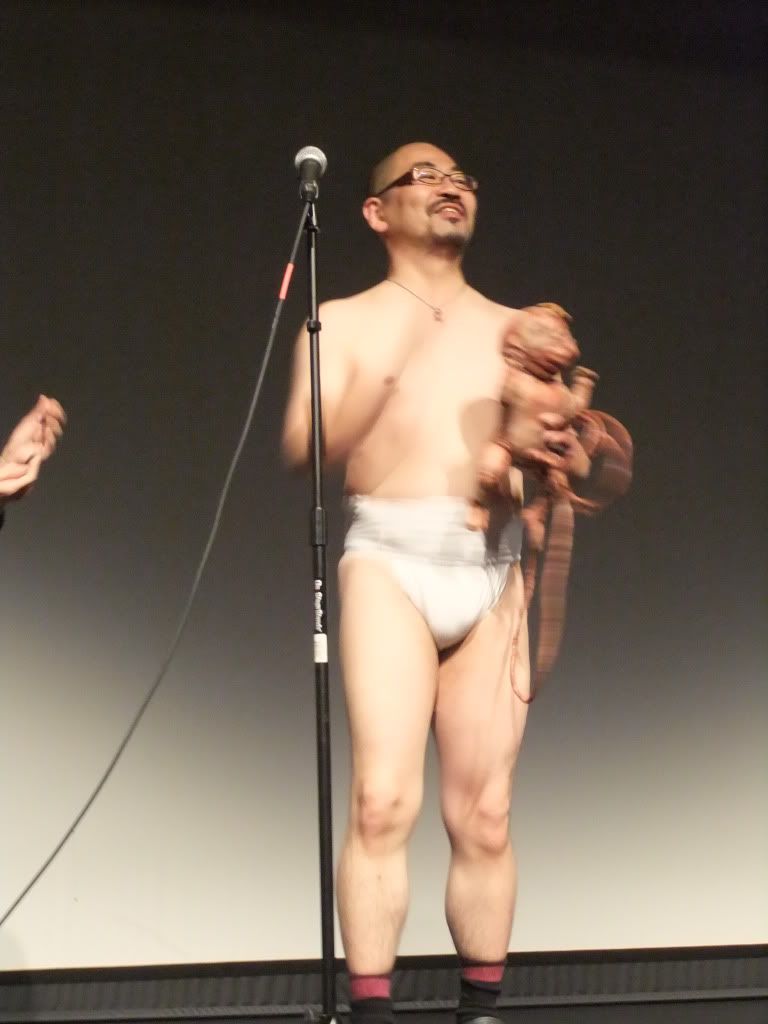
With all of the exciting distractions surrounding the recent screening of Helldriver at Japan Society, it’s possible to overlook…Helldriver! We shouldn’t do that. It is a wild ride of a movie that finds Nishimura breaking out of the mold of great ‘fringe director’ and achieving acknowledgment as a great director, period. It is his best work yet, ideally experienced in a theater, as evidenced by the audience cheering raucously throughout.
It is the story of a young woman, Kika. She is on a road to revenge against her serial-killing psychopath mother (played by Eihi Shiina of Audition and Tokyo Gore Police fame)and uncle. And by the way, Japan is a zombie wasteland.
Yes, Helldriver finds Nishimura taking on the zombie genre. But naturally, instead of merely making another entry into the genre, the special effects maven has created his own unique take on the undead. According to Nishimura’s vision, the affliction is the result of a meteoric object colliding with earth. The zombies have a distinguishing feature in the form of gnarled fleshy antennae protruding from their foreheads. The mental capacity of these zombies seems to shift throughout the movie. At times, they are the drooling, mindless, hungry beasts we are accustomed to. At others, we get hedonistic zombies, who subject their un-undead human victims to fiendish forms of torture and molestation. Since the movie works as much as a comedy as it does a horror or action film, we’ll hold no grudge over the inconsistency.
When referring to the movie as a comedy, I should make it clear that Helldriver stands up to the most well known movies that have taken humorous stabs at the zombie genre. Bad Taste, Shawn of the Dead…it doesn’t take a back seat to any of them. Nishimura’s great comedic sense comes by way of inserting hilarious scenes at just the right moments, throwing the audience for a loop right when the tone seems to be leaning towards suspense or drama. The laughs are also hard-earned because, rather than just go for gross-out humor, they involve some serious political satire. The way in which the main characters are “assigned” their mission to track down the evil Zombie Queen (also Kika's mother, portrayed with gleeful savagery by Shiina) takes a hilarious shot at prison complexes and the notions of reform and correction.
Yes, there are the larger than life gore-effect spectacles that fans of this new wave of Japanese splatter film come to expect. Before the end credits roll, you will see more than one moving vehicle that is made out of teeming hordes of zombies. A large scale battle scene shifting between 3 simultaneous duels to the death involves creatures with multiple limbs, a zombie infant that is wielded as a weapon (which Nishimura lovingly embraced after the screening), and a car that fights with Mortal Kombat-like video game proficiency.
The most interesting parts of the movie for me, however, show a dystopian vision of Japan after being rocked by this national crisis (which may hit a little close to home; Nishimura, during the Q & A, acknowledged the unsettling parallels between the film and recent situations after Japan’s recent earthquake disaster, although he finished the movie before it occurred). Much time is spent delving into the hell that the zombie-infected communities have fallen into, showing the divisive campaigns of politicians and religious figures in reaction to the catastrophe, and how none of them adequately handle the everyday citizens’ needs. Other societal questions are explored, like what occupation do people turn to for a living in a world turned upside down by a zombie plague, and how are illicit activities, such as the drug trade, affected? Both of these questions are answered as Kika encounters those who would become her allies in her enormous quest.
Certain moments of the film show a clear influence by director Sono Sion, in particular his movie Love Exposure. There are scenes of unsettling abusive behavior set to sweeping classical scores and also an explosive title sequence that doesn’t appear on the screen until a full hour into the movie – both reminiscent of that epic movie. Before anyone cries foul, let’s remember that Nishimura was involved in Love Exposure’s success, bringing his splatter expertise to designing the gore effects of that movie. It is exciting to see Japan’s bold and provocative directors having a positive influence on one another.
Helldriver is an overwhelmingly satisfying film that leaves the question, what‘s next for Nishimura? at the forefront of fans’ minds. For a glimpse of a possible answer to that question, be sure to stick around ‘til after the credits!

No comments:
Post a Comment